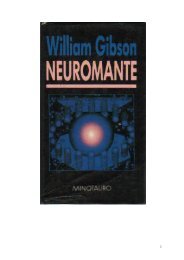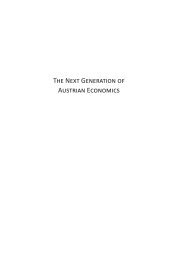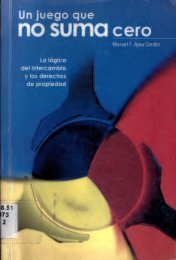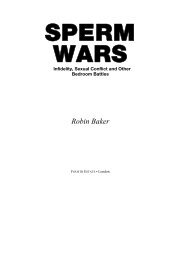capitalist_and_entrepreneur_klein
capitalist_and_entrepreneur_klein
capitalist_and_entrepreneur_klein
Create successful ePaper yourself
Turn your PDF publications into a flip-book with our unique Google optimized e-Paper software.
19<br />
firm (Boudreaux <strong>and</strong> Holcombe, 1989, p. 152). Williamson’s transaction<br />
cost economics, as characterized by Langlois (1994a, p. 175), does broaden<br />
the notion of cost minimization to include transaction costs as well as production<br />
costs, but it remains essentially a static exercise with a limited role<br />
for expectations: “Seldom does the theory give thought to the possibility<br />
that organizational forms may be influenced as much by environments that<br />
exist only as future possibilities, imagined or feared.”<br />
To be sure, the Knightian concept of the profit-seeking <strong>entrepreneur</strong>,<br />
investing resources under uncertainty, is one of the great contributions<br />
to the theory of the firm. As discussed in chapters 4, 5, <strong>and</strong> 6 below, it<br />
is close to Mises’s concept of the <strong>entrepreneur</strong> (closer, in my view, than<br />
Israel Kirzner’s underst<strong>and</strong>ing of <strong>entrepreneur</strong>ship). Still, these critiques<br />
of the Coasian framework paint with too broad a brush; as Foss (1993c)<br />
points out, there are “two Coasian traditions.” One tradition, the nexus-ofcontracts<br />
branch associated with Alchian <strong>and</strong> Demsetz (1972), studies the<br />
design of ex ante mechanisms to limit shirking when supervision is costly.<br />
Here the emphasis is on monitoring <strong>and</strong> incentives in an (exogenously<br />
determined) moral-hazard relationship. e aforementioned criticisms<br />
may apply to this branch of the modern literature, but they do not apply<br />
to the other tradition, the governance or asset-specificity branch, especially<br />
in Williamson’s more heterodox formulation. Williamson’s transaction<br />
cost framework incorporates non-maximizing behavior (bounded rationality);<br />
true, “structural” uncertainty or genuine surprise (complete contracts<br />
are held not to be feasible, meaning that all ex post contingencies cannot<br />
be contracted upon ex ante); <strong>and</strong> process or adaptation over time (trading<br />
relationships develop over time, typically undergoing a “fundamental<br />
transformation” that changes the terms of trade). In short, “at least some<br />
modern theories of the firm do not at all presuppose the ‘closed’ economic<br />
universe—with all relevant inputs <strong>and</strong> outputs being given, human action<br />
conceptualized as maximization, etc., that [some critics] claim are<br />
underneath the contemporary theory of the firm” (Foss, 1993a, p. 274).<br />
Stated differently, one can adopt an essentially Coasian perspective without<br />
ab<strong>and</strong>oning the Knightian or Austrian view of the <strong>entrepreneur</strong> as an<br />
uncertainty-bearing, innovating decision-maker. 16<br />
16 Nor do all Coasian perspectives deny the importance of specialized knowledge lines<br />
in determining a firm’s capabilities or “core competence.” Transaction cost economics, for<br />
example, simply holds that the need for ex post governance of contracts in the presence








